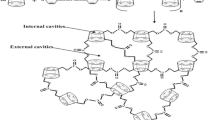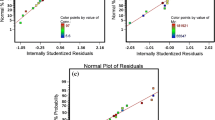Abstract
The reaction of polymerization of cyclodextrins with suitable polyfunctional agents leads to highly cross linked porous structures, referred to as cyclodextrin nanosponges. The conventional heating approach for the synthesis of nanosponges can lead to nonuniform reaction conditions caused by sharp thermal gradients in the bulk solution. In this work, we present a facile method for the synthesis of cyclodextrin nanosponges by microwave irradiation with significant reduction in reaction time. Response surface methodology and Box–Behnken design were used for the optimization of the process parameters including microwave power level (A), reaction time (B) and stirring speed (C). Two dependent variables practical yield and particle size were measured as responses. Mathematical equations and response surface plots were used to relate the dependent variables with independent variables. The optimization model predicted a yield of 96.5287 % and particle size of about 152.355 nm with A, B and C levels of 508.22, 83.55 and 1,471.55 respectively. The observed responses of the optimized process were in close agreement with the predicted values. Three confirmation batches of cyclodextrin nanosponges were synthesized under optimized conditions. The Fourier transformed infrared spectra of nanosponges showed a characteristic peak of the carbonate group at around 1,750 cm−1 which confirms the formation of nanosponges. TGA revealed the stability of obtained nanosponges up to 325 °C. The nanosponges obtained by microwave irradiation exhibited a higher degree of crystallinity. Dimension of the crystal lattice was found to be equal to 0.70 nm. TEM image confirmed the spherical shape and the particle size range of about 153 nm. Compared to conventional heating method, microwave method resulted in four folds reduction in reaction time and provided with particles of homogeneous size distribution and uniform crystallinity.









Similar content being viewed by others
References
F. Trotta, M. Zanetti, R. Cavalli, Beilstein J. Org. Chem. 8, 2091 (2012)
R. Cavalli, F. Trotta, W. Tumiatti, J. Incl. Phenom. Macrocycl. Chem. 56, 209 (2006)
F. Castiglione, V. Crupi, D. Majolino, A. Mele, B. Rossi, F. Trotta, V. Venuti, J. Phys. Chem. B. 116, 7952 (2012)
C. Longo, G. Gambara, V. Espina, A. Luchini, B. Bishop, A.S. Patanarut, E.F. Petricoin 3rd, F. Beretti, B. Ferrari, E. Garaci, A. De Pol, G. Pellacani, L.A. Liotta, Exp. Dermatol. 20, 29 (2011)
S. Renuka, P. Kamla, Pharm. Dev. Technol. 16, 367 (2011)
A. Baglieri, M. Nègre, P. Cavallaro, F. Trotta, C. Abbate, M. Gennari, Organo-clays and nanosponges for acquifer Bioremediation: adsorption and degradation of Triclopyr. (GeoMed—4th International Conference on Medical Geology, 2011), http://www.cprm.gov.br/pgagem/bari_italia/10.pdf. Accessed 25 Jan 2014
B.B. Mamba, R.W. Krause, T.J. Malefetse, G. Gericke, S.P. Sithole, J. Water Supply Res. 34, 299 (2008)
B. Boscolo, F. Trotta, E. Ghibaudi, J. Mol. Catal. B Enzym. 62, 155 (2010)
L. Seglie, K. Martina, M. Devecchi, C. Roggero, F. Trotta, V. Scariot, Plant Growth Regul. 65, 505 (2011)
R. Cavalli, A.K. Akhtera, A. Bisazzaa, P. Giustettoa, F. Trotta, P. Vavia, Int. J. Pharm. 402, 254 (2010)
J. Alongi, M. Poskovic, A. Frache, F. Trotta, Polym. Degrad. Stabil. 95, 2093 (2010)
J. Alongi, M. Poskovic, A. Frache, F. Trotta, Carbohydr. Polym. 86, 127 (2011)
V. Crupi, A. Fontana, M. Giarola, D. Majolino, G. Mariotto, A. Mele, L. Melone, C. Punta, B. Rossi, F. Trotta, V. Venuti, J. Raman Spectrosc. 44, 1457 (2013)
S. Swaminathan, L. Pastero, L. Serpe, F. Trotta, P. Vavia, D. Aquilano, M. Trotta, G. Zara, R. Cavalli, Eur. J. Pharm. Biopharm. 74, 193 (2010)
S. Swaminathan, P.R. Vavia, F. Trotta, R. Cavalli, S. Tumbiolo, L. Bertinetti, A. Coluccia, J. Incl. Phenom. Macrocycl. Chem. 76, 201 (2013)
F. Trotta, R. Cavalli, W. Tumiatti, O. Zerbinati, C. Roggero, R. Vallero, European Patent EP 1 786 841 B1(2009)
S. Komarneni, R. Roy, Mater. Lett. 3, 165 (1985)
S. Komarneni, R. Roy, Q.H. Li, Mater. Res. Bull. 27, 1393 (1992)
S.H. Jhung, J. Lee, J. Chang, Bull. Korean Chem. Soc. 26, 880 (2005)
H. Su, H. Xu, S. Gao, J.D. Dixon, Z.P. Aguilar, A.Y. Wang, J. Xu, J. Wang, Nanoscale Res. Lett. 5, 625 (2010)
R. England, Microwave Synthesis: a new wave of synthetic organic chemistry. (Labplus International, 2003), http://pns.phosworks.se/general/graphics/599.pdf. Accessed 10 Jan 2014
C. Leonelli, W. Lojkowskil, Main development directions in the application of microwave irradiation to the synthesis of nanopowders. (Chemistry Today, 2007), http://mms.technologynetworks.net/articles/leonelli.pdf. Accessed 12 Feb 2014
N. Dahal, S. Garcia, J. Zhou, S.M. Humphrey, ACS Nano 6, 9433 (2012)
A.B. Panda, G. Glaspell, M.S. El-Shall, J. Phys. Chem. C 111, 1861 (2007)
R. Maa, P. Zhoua, H. Zhana, C. Chena, Y. He, Optics Commun. 291, 476 (2013)
S. Selvamuthukumar, S. Anandam, K. Kannan, R. Manavalan, J. Pharm. Pharm. Sci. 15, 103 (2012)
Q. Zhang, X. Tian, G. Du, Q. Pan, Y. Wang, X. Zhang, J Chem. 505460, 1 (2013)
A.M. Hamam, J. Appl. Sci. Res. 5, 1772 (2009)
R.Z. Ahmed, G. Patil, Z. Zaheer, Drug Dev. Ind. Pharm. 39, 1263 (2013)
Acknowledgments
We are very much grateful to UGC-SAP-DRS–PHASE I, New Delhi, India for providing the facilities to carry out this work. We would like to thank Prof. K. Venu Gopal Reddy (Director, Central Facilities for Research and Development, Osmania University, Hyderabad) for assistance with FTIR analysis and Mr. Rajender (Centre for Nano Science and Technology, Jawaharlal Nehru Technological University, Hyderabad) for technical support with the XRD and TEM.
Author information
Authors and Affiliations
Corresponding author
Rights and permissions
About this article
Cite this article
Anandam, S., Selvamuthukumar, S. Optimization of microwave-assisted synthesis of cyclodextrin nanosponges using response surface methodology. J Porous Mater 21, 1015–1023 (2014). https://doi.org/10.1007/s10934-014-9851-2
Published:
Issue Date:
DOI: https://doi.org/10.1007/s10934-014-9851-2




